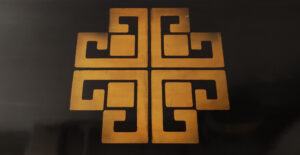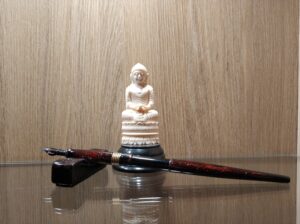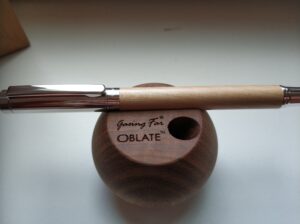There I was, just sitting in the backroom of the workshop. The air was swelteringly hot and filled with the smell of sweat from the men who worked on their special projects. It was the end of the day and the last sunrays touched the window. A small window near the ceiling, covered with wood and metal dust from generations of craftsmanship and hard labour. I knew I had to switch on the lights, but I was afraid that the flickering and buzzing of the old lamps wasn’t going to help me to concentrate. And concentration was just crucial for this project…
Good to know
- First I want to stipulate that in the beginning this started as a personal search for paper that could handle the Zebra G-flex nib and the Regalia Writing Labs crossflex. Just because I wasn’t happy on how these nibs preformed on some standard paper of well-known brands;
- Some people asked me to share my findings so I thought to enlarge the original scope with more pens and a variation of ink. Still my findings are personal and are absolutely no accurate science. From each type of paper or notebook I took a random page and did the same kind of writing test. So be aware that I could just have picked the best or the worst page out of the book/stack. I noticed myself that some paper did better or worse during this test than what I expected based on previous experiences with that same paper;
- All paper has been paid for. Most of it I bought myself and some I got from friends during pen or stationery meetings or was send to me for this project. Although I could easily get free samples I refused to go this way so I could do this testing with a clear conscious and in total independence;
- The test is done on some common and less common paper. Not all brands or paper types are tested because that would take too much time and money. I tried to incorporate all the paper that was recommended by my IG friends in the comments of the posts of my testing project. Over time extra paper can be added to the test;
- I only tested the paper as such. I didn’t look at the quality of the cover or the way papers were kept together. I know they are important for many pen user but they are so subjective that I didn’t want to incorporate this in the testing. For the same reason I didn’t take the kind of ruling into account.
The testing
My first idea was just to see how the paper could endure some special nibs. I took Colorverse Gravity Wave ink because it was the bottle that was the closest to me when I started and I knew it had some sheen. I thought one ink would be fine and did put it in the fountain pens I was going to use for the test:
- Wancher True Ebonite Dream pen – EF nib
- Marte Modena hand painted dragon – Zebra G-flex nib
- Additive pens Double Helix – Regalia Writing Labs Crossflex
- Opus 88 Demonstrator – Regalia Writing Labs Trilogy
After my first posts about this project and the input I got from the Instagram community, I decided to enlarge the test with some additional normal nibs and standard well performing inks:
- Write Turnz Dragon – Jowo 1.1 stub nib, Iroshiszuku kon-peki;
- Parker Duofold – Parker M nib, Pelikan 4001 Royal blue.
I made a template of 14 x 10 cm (5.5 x 3.9 inch) in an attempt to do the same test on each paper. But as not all is done on the same day, there could be some variation due to the fact that I’m human. I also changed my system a bit during the testing. Also not all paper had the same size so for some paper the template was too big and I tried to give a comparable impression.
Because the Zebra G-flex is a dip pen nib that I forced into a fountain pen it suffered during the testing on some less fountain pen friendly paper. The fine lines weren’t as fine anymore, the ink started to come with a different flow and the tines didn’t align as good anymore. So after 80% of the testing it got so bad that I replaced it with another one. This can be seen on some of the papers, but it didn’t affect the test as such.
The scores
First two parameters are rather objective and determine if the paper is fountain pen friendly. For these aspects I looked really on details. One small bit of feathering or just a little spot of bleeding through was enough to lose points.
Feathering (F)
- 3: absolutely no feathering
- 2: only feathering with special nibs
- 1: minor feathering with normal nibs
- 0: this is almost blotting paper
Bleeding through (B)
- 3: nothing to see
- 2: only bleeding through with special nibs
- 1: bleeding through with normal nibs
- 0: bleeding onto the next page (with special or normal nib)
Basic evaluation
- special nib friendly (SF): minimal 3 for feathering and bleeding through
- fountain pen friendly (FF): minimal 2 for feathering and bleeding through
Ghosting and sheen are not as import for everybody. Some don’t use inks with sheen and some don’t use the backside of a paper, so I consider these aspects as rather subjective. For me they do matter so good sheen and less ghosting gives a higher score. The drying time of ink wasn’t measured, but is in most cases inversely proportional to the amount of sheen.
Ghosting (G)
- 3: no ghosting – no way I did use the other side of this paper
- 2: minor ghosting with special nibs, almost no ghosting with normal nibs
- 1: minor ghosting with normal nibs, you can still use the back side
- 0: just forget that the paper has a back side
Sheen (S)
- 2: cover your eyes, overload of sheen
- 1: some sheen can be detected
- 0: looks like I used a matte ink
I also added real subjective scores regarding to how I felt about the paper or certain aspects that I noticed during the testing. I must say that I love smooth paper that lets your nib dance on the flow of ink. I know that some people just like more feedback from the paper whilst writing and are not so keen on real smooth paper.
Writing feeling (W, based on writing with the normal nibs)
- 2: nice writing on this paper
- 1: it’s just paper
- 0: why did I even try to write on this paper?
Others (O)
- 1: nice or positive thoughts/feeling/detected aspects
- 0: nothing special to mention
- -1: I just have to warn you
The results
Final conclusions
Keeping in mind the limitations of the tests I did and my personal preferences (smooth paper and minimal ghosting) the next papers can be valued as best of the test to use for all fountain pens (special nibs and normal nibs). Additional remark: some notebooks/papers are available in different sizes but only the tested size is taken into account.
A4/B5 – loose paper (12/14):
Clairefontaine Triomphe, Life “L” Brand writing paper
A4/B5/large – notebook (12/14):
Rhodia Pro book
A5 – loose paper (13/14):
Viking 1914 Vektor 70
A5/B6/medium – notebook (12/14):
Constellation 88 Ruled journal, Franklin-Christoph Firma-flex, Hippo Noto Pocket A5, Leuchtturm 1917 Notebook medium, Life Noble Note, Maruman Mnemosyne Inspiration notebook, Midori 10th anniversary, PenGallery Lifenotes, Taroko Design Breeze notebook
Traveler’s/traveller’s regular size (12/14):
Inky Fingers Traveller’s, Traveler’s refill 003 (Midori 80g), Captain Scott’s notebook
Test Data
After testing all papers were scanned as proof of the result. These scans are available in a separate blog post.
An alternative version of the test data is available as Excel-file . In this version there is no final score, and you are able to look what could be the best paper for you (parameters: special nib/normal nib, double sided use of paper, need for sheen, smoothness/responsiveness of the paper, size and ruling). You may use this data as you like, but if you share it, please do not remove the source references.


